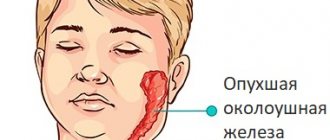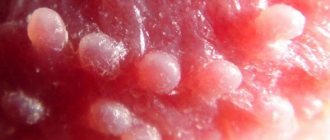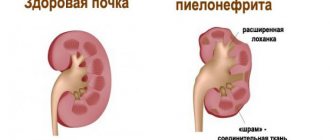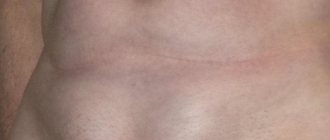A hiatal hernia (HH) is a chronic disorder in which the abdominal part of the esophageal tube and the cardia of the stomach leak into the chest cavity. This disease is often asymptomatic, it has no external signs, and many do not even suspect about it until complications appear. The diagnosis of a hiatal hernia can be an accidental discovery, even for a doctor during an examination of the chest or gastrointestinal tract for another abnormality.
The hiatal hernia is associated with a pathology of the musculo-ligamentous apparatus; the abdominal organs are pushed under pressure through the diaphragm into the chest. Although the disease is asymptomatic in most cases and does not always require surgical treatment, it leads to disruption of the functioning of many organs, which can already lead to serious consequences. A hiatal hernia can occur at any age in both women and men.
What is a hiatal hernia
The chest cavity and abdominal cavity are separated by a muscular septum - the diaphragm. Their connection is carried out through openings in the diaphragm for the veins, aorta and esophagus. A disease caused by the displacement of abdominal organs into the thoracic cavity through the opening of the esophagus is called a hiatal hernia. The disease is diagnosed quite often in the older generation, especially in women over 50 years of age.
Exercises for reduction of diaphragmatic hernia
To eliminate a diaphragmatic hernia without surgery, two types of activity are used: physical and respiratory. Classes are aimed at placing organs in a topographically correct position and strengthening the muscles that support the ligaments.
Physical exercise
Classes are held 30–40 minutes before meals; the complex makes it possible to eliminate pain and discomfort.
It is performed lying on your back with the head raised, the 2nd and 3rd fingers of both hands are located under the ribs in the epigastric region. When exhaling, the fingers are pressed into the abdominal space, which forces the stomach to return to the subdiaphragmatic zone.
Exercises can be performed while sitting, hunching your back, and weakening your abdominal muscles. Place the first fingers of your hands under the ribs, the rest in the middle of the abdomen. When you inhale, the pressure is up, when you exhale, the pressure is down. Physical exercises are performed without stress and pain.
Breathing exercises
The complex is most effective for sliding hiatal hernia and helps cure the disease without surgery.
Lying with your head raised, inflate your stomach as much as possible as you inhale, and relax as you exhale. After a week of regular exercises, when exhaling, they do not relax, but draw in the abdomen. 3–5 approaches per day for 7–10 minutes are enough.
In the initial kneeling position, bend to the side. When inhaling - tilt, when exhaling - return to the starting point. After 5–7 days they switch to standing on their feet.
Gymnastics is performed on an empty stomach half an hour before meals. Correct execution can be seen in the video.
Emergency treatment for strangulation
What to do if the hernial sac is strangulated? In this case, treatment is only surgical. Moreover, the outcome of the intervention depends on how quickly the patient is taken to a medical facility, since if there is a malnutrition, the compressed tissues quickly die.
Removal of necrotic areas and suturing of the hernial opening is carried out under general anesthesia using an open abdominal approach. In this case, an anastomosis (artificial connection) is created between the stomach and the intact part of the esophagus.
Dietary rules
Nutrition for a hiatal hernia does not have strict restrictions; the menu looks like a recommendation for a healthy lifestyle:
- fractional meals;
- exclusion of alcohol, soda, chocolate, tomato products, spices;
- weight control;
- avoiding overeating and late-night eating.
A diet should not be a temporary measure to relieve discomfort; it should become a part of life.
If you suspect you have symptoms of an esophageal hernia, which doctor should you consult? Diagnosis and treatment are carried out by a gastroenterologist, and if surgical intervention is necessary, by an abdominal surgeon.
Causes
With pathologies in the muscles of the esophageal opening - congenital or acquired - a hiatal hernia appears. This causes the esophageal ring to expand, causing part of the stomach and sometimes part of the intestine to enter the chest cavity. In the medical classification, the causes of the development of this disease include:
- congenital pathologies;
- increased intra-abdominal pressure;
- age-related changes;
- chronic diseases.
An acquired hernia is most often a consequence of increased pressure in the abdominal cavity. Pregnancy, severe cough, prolonged vomiting, heavy lifting, obesity are factors leading to the development of the disease. Inflammatory diseases, peptic ulcers of the stomach and duodenum are also the cause of disruptions in esophageal peristalsis.
Etiology of hernia
In most cases, a hernia is treated conservatively, so it is important to identify the main factor in its development in order to eliminate it during therapy. Various reasons can aggravate symptoms, so you need to know them and try to avoid them.
- Muscle weakness of the diaphragm and high elasticity.
This factor is important already in old age, when physiological aging occurs, tissues lose elasticity and activity, nutrition is disrupted, which leads to a defect in the diaphragmatic opening. Muscle weakness causes the natural opening to widen under pressure. This factor explains the predisposition to hernia after 55 years of age, which is often aggravated by an inactive lifestyle and bad habits.
- High intra-abdominal pressure.
This occurs with constant overeating, constipation, and during pregnancy. The pressure can increase once or remain constantly at a high level. The cause may be ascites, chronic cough, heavy physical work. Any factor that increases intra-abdominal pressure (overeating, constipation) can be the main cause of a hiatal hernia.
- Shortening of the esophagus and impaired peristalsis.
Some diseases can lead to a physiological increase in the level of the esophagus, which simultaneously leads to an increase in its function, therefore, the pressure in the organ increases. The cause of the disorder is pathologies such as pancreatitis, ulcers, polyps, scar changes, stenosis, chemical and thermal burns.
- Diaphragm injury.
The reason for the expansion of the diaphragm opening may be its open or closed damage. The muscular-ligamentous system may suffer from bruise, wound with a knife or other piercing objects.
Classification
Manifestations of the disease are different. Depending on the characteristics, the “International Classification of Diseases ICD-10” identifies the following types of esophageal hernia:
- sliding (axial);
- paraesophageal (paraesophageal);
- congenital.
Sliding is the most common form of the disease. It is characterized by the fact that the lower part of the esophagus, as well as the stomach, freely passes through the hole in the diaphragm into the chest cavity. Sometimes organs are able to return on their own if the patient changes his body position. Usually such hernias are small and do not cause serious inconvenience.
The peri-esophageal form appears less frequently. In this case, the lower part of the esophagus remains motionless, and the fundus of the stomach passes through the opening of the diaphragm. The organ becomes severely distorted, which leads to serious complications.
Disorders of embryonic development and anomalies in the structure of the gastrointestinal tract are the cause of the appearance of a congenital hernia. In such cases, the esophagus is not sufficiently formed - its length does not coincide with the size of the chest. The stomach is partially clamped by the diaphragm. Diagnostics reveals the disease in children at an early age.
Photo: hiatal hernia
Diagnostics
The first step in detecting a diaphragmatic hernia is to look for the patient's characteristic symptoms and possible causes. After this, it is necessary to proceed with a direct examination, during which the following signs of the disease can be detected:
- Inspection - with a hiatal hernia, the chest practically does not move during breathing, due to dysfunction of the diaphragm. If a person suffers from this pathology for a long time, the stomach becomes “sunken”. This symptom may not be observed in people who are overweight;
- Feeling the abdomen (palpation) - it becomes dense in the upper parts of the abdominal wall due to strong muscle tension. Pain on palpation is also possible;
- Auscultation (listening with a phonendoscope) - a characteristic sign of a diaphragmatic hernia is the appearance of bowel sounds in the chest cavity. The normal sound of breathing is usually absent or significantly reduced.
The above signs are enough to suggest a diagnosis. However, the presence of a hiatal hernia can only be reliably confirmed using instrumental diagnostic methods:
- Radiography using radiation-contrasting barium sulfate. Gives an idea of the state of the digestive tract along its entire length, determines the presence of a hernial sac and its location.
- Ultrasound allows you to assess the level of development of pathology. Determines the degree of involvement of neighboring organs, the size and type of hernial formation.
- FGDS - endoscopic diagnostics allows you to visually assess the situation, determine what the esophageal mucosa looks like, and how much the organ has suffered from compression.
In addition, the diagnosis of a hernia includes laboratory tests, biochemical tests and an analysis of the acidity of gastric juice.
How to prepare for an x-ray?
In order for the image to be reliable and of high quality, you need to prepare 3 days before the procedure:
- During this period, the patient should adhere to a dietary diet that should include a minimum amount of fiber. It is necessary to remove rye bread, pearl barley and corn grits, dairy products, fruits, vegetables and their derivatives (juices, jam, etc.) from the menu.
- 12 hours before the examination, you need to follow a “fasting” diet and not eat anything.
- In the evening and morning before the procedure, the patient will be given a cleansing enema.
It is necessary to highlight the fact that taking laxative drugs is not recommended, since they increase the amount of free gas in the intestinal tract and reduce the quality of the diagnosis.
Differential diagnosis
A hiatal hernia should be differentiated from:
- pathology accompanied by esophagitis;
- angina pectoris;
- damage to the nerves of the thoracic spinal cord;
- relaxation of the dome of the diaphragm;
- Casten's syndrome (hiatal hernia, cholecystitis, duodenal ulcer);
- Saint's triad (esophageal hernia, colon diverticula, cholelithiasis).
Symptoms and signs
In the early stages, a hiatal hernia does not cause any discomfort. Over time, the disease progresses and characteristic symptoms appear:
- pain in the lower chest;
- heartburn;
- frequent belching.
Pain occurs as a result of changes in the position of organs - reflux. It is especially noticeable after eating or in a lying position, and can be pressing or sharp. By these signs, a hernia can be distinguished from angina pectoris, with which it is often confused, since it can stab in the area of the heart.
Reflux causes stomach acid to irritate the walls of the esophagus, causing heartburn. It manifests itself in the same cases as the first symptom. Heartburn most often occurs at night, when the lower esophageal sphincter relaxes, which does not hold the stomach contents well.
Frequent belching of air is a characteristic sign of a hiatal hernia that occurs after eating, since a full stomach increases intraluminal pressure. Aerophagia—swallowing air while eating—complicates this symptom. In some cases, regurgitation of sour or bitter liquid is possible.
Symptoms of hiatal hernia
For a long time, the axial (sliding) hiatal hernia is asymptomatic or with minimal symptoms. When, as the disease progresses, the symptoms become well defined, the anatomical changes reach a significant extent.
The main signs of a hiatal hernia:
- Heartburn – at the beginning of the disease it occurs after errors in the diet or after a heavy meal, in later stages it bothers patients almost constantly.
- Pain in the epigastrium and retrosternal region is aching and drawing in nature, occurs after eating, significantly decreases or goes away when taking antacids.
- Belching, usually air or sour, occurs after eating and brings some relief.
- Regurgitation is most often detected when the body is tilted, as well as at night in a horizontal position.
- Dysphagia is an intermittent symptom that often occurs when swallowing hot or too cold food.
- Pain, burning tongue, stomatitis, damage to tooth enamel.
- The phenomena of laryngitis and pharyngitis.
- Dry, exhausting cough, often accompanied by symptoms of chronic bronchitis or pneumonia.
- Unpleasant sensations in the pericardial region, often accompanied by extrasystole.
Methods for diagnosing hiatal hernia
Since the disease is asymptomatic for a long time, hiatal hernia is diagnosed by doctors in the later stages of development. It is difficult to identify the disease if it is combined with other diseases - peptic ulcer, cholecystitis, colon diverticulosis. Gastroenterologists identify a hiatal hernia using diagnostic methods such as:
- X-ray examination;
- endoscopy;
- esophageal manometry.
Radiography is the most informative technique for studying the condition of the gastrointestinal tract. The mixture taken by the patient on an empty stomach, clearly visible on the X-ray image, makes it possible to assess the condition and location of the esophagus and stomach. To examine the mucous membrane of the esophagus, endoscopy is used. The method is suitable for identifying indirect signs of a hiatal hernia and the presence of tumors. Manometry, in turn, makes it possible to obtain information about the functioning of the esophageal sphincter, thereby separating a hiatal hernia from other diseases associated with disorders of movement and retention of gastric juice.
Treatment methods
The main goal of treatment of uncomplicated hiatal hernia is the elimination of reflux esophagitis. Drug therapy is aimed at reducing the production of gastric juice to minimize contact of the esophageal mucosa with aggressive hydrochloric acid.
For a hernia, treatment includes taking the following groups of medications:
- Antacids - Phosphalugel, Rennie, Alma-Gal. Indicated for neutralizing acid.
- H2 blockers – Nizatidine, Famotidine. Reduce acid production.
- Bile acids – Allochol, Festal, Urochol. Neutralizes acid in the stomach.
- Antispasmodics and painkillers – No-Shpa.
Folk remedies help to cope well with the signs of hiatal hernia:
- for heartburn - a decoction of orange peels and flax seeds;
- for belching - cranberry infusion with honey and a few drops of aloe juice;
- for bloating - a decoction of yarrow with mint, chamomile infusion;
- for constipation - dried fruit compote, rhubarb decoction and infusion of hay leaves.
Indications for surgery
Surgical treatment of the hiatal hernia is a last resort measure to eliminate the defect. Surgery is prescribed for severe complications that cannot be treated with conservative methods.
When a decision is made about radical treatment of a hiatal hernia:
- paraesophageal hernia with risk of strangulation;
- damage to the hernial sac and gate;
- deterioration due to esophagitis;
- ineffectiveness of conservative therapy;
- addition of complications - polyps, ulcers, bleeding.
Treatment of the disease
Medicines prescribed for hiatal hernia are mainly aimed at reducing the acidity of gastric juice, as well as reducing acid production. The disease can be treated with the following drugs:
- antacids;
- prokinetics;
- histamine receptor blockers;
- proton pump inhibitors.
Despite the fact that most of the medications listed do not require a doctor's prescription, you should not self-medicate without consulting a specialist.
Surgery is used for complications in the development of the disease, or when drug treatment has not been effective. Depending on the characteristics of the disease, surgery is performed to strengthen the esophageal-phrenic ligament, fix the stomach, and also to prevent or eliminate organ reflux.
For a long time, hiatal hernia has been treated with folk methods - the beneficial properties of some plants can ease the manifestation of symptoms. Recipes often use stone drupes, propolis, gooseberries, and flax seeds. To eliminate constipation, leading to increased pressure in the abdominal cavity, it is recommended to drink compote from prunes or dried apricots, and also brew a drink from buckthorn leaves.
Table of contents
Symptoms of hiatal hernia
Physical method for diagnosing hiatal hernias (based on medical examination)
Hiatal hernia: classification
Paraesophageal hiatal hernia or fixed hiatal hernia
Unfixed axial hiatal hernia
Is it possible to cure a hiatal hernia without surgery?
Treatment of hiatal hernia treatment without surgery
Drug treatment
Exercises for hiatal hernia
Diet for hiatal hernia and menu
Lifestyle with hiatus hernia
The role of traditional medicine in the treatment of hiatus without surgery
In what cases is it impossible to treat a hiatal hernia without surgery?
Diet for illness
Following a diet, proper and balanced nutrition - this is where the treatment of any disease of the digestive system, including hiatus hernia, begins. From the diet you need to exclude foods containing animal fat, which irritate the esophagus:
- fried foods;
- canned foods;
- hot and salty seasonings;
- citruses;
- strong coffee.
Chopped and mushy food is preferred, taken in small portions every 3 hours. You should have dinner no later than a few hours before bedtime. The patient should refrain from smoking and alcohol.
Folk remedies
You can treat a hiatal hernia using the following traditional methods:
- The simplest remedy is chamomile or mint tea, which eliminates a burning sensation in the throat. The discomfort will disappear if you drink a cup of the drink after eating.
- The mucous membrane will calm down under the influence of an infusion of 300 ml of water and 1 tsp. carrot seeds. The mixture must be brought to a boil, but not boiled. Drink warm once a day after breakfast. The course of treatment is a month.
- A decoction of dry gooseberry leaves: 60 grams of raw materials are placed in a liter of boiling water and left for 2-3 hours. The resulting product is taken 0.5 cups before meals.
- Mix in equal proportions: coltsfoot, marshmallow rhizomes, flax seed. Pour 90 grams of the mixture into a liter of boiling water and simmer for no more than 10 minutes. The medicine is taken chilled 4-5 times a day, half a glass.
- Decoction of aspen bark. To prepare the product: 2 tbsp. pour a glass of boiling water over the raw materials and cook over low heat for 10 minutes. Then leave for another hour and filter. Divide the resulting amount into 2 doses, take in the morning and evening.
- Carrot juice (freshly squeezed, diluted with a small amount of boiled water). The juice should be taken in small portions (100 g each) 3 times a day 20 minutes before meals;
Prevention
Diet, weight control, and a healthy lifestyle are reliable measures to prevent the development of a hiatal hernia. Physical therapy that strengthens the abdominal muscles will help keep the diaphragm in good shape. However, there is no need to overexert yourself - do too heavy exercises, lift weights, or push too hard on the toilet, as this increases intra-abdominal pressure. Compliance with the rules of prevention will help avoid relapse of the disease.
Project consultant, co-author of the article: Ovchinnikova Natalya Ivanovna | Gastroenterologist, Hepatologist, Infectious disease specialist 30 years of experience / Doctor of the highest category, Candidate of Medical Sciences
Education:
Diploma in General Medicine, Novosibirsk State Medical Institute (1988), Residency in Gastroenterology, Russian Medical Academy of Postgraduate Education (1997)
Hiatal hernia: main signs and symptoms
Symptoms and signs of a hiatal hernia, as well as the intensity of manifestations, are determined by the size of the formation. At the initial stages, the clinical picture of the disease is completely absent or manifests itself sporadically in the form of reflux.
Healthy appearance of the esophagus and stages of hernia formation in the photo:
Symptoms of the disease
As a rule, the symptoms of a hiatal hernia are attributed to other pathologies of the digestive tract or associated with dietary errors:
- The main symptom of the pathology is heartburn. It appears immediately after eating food, when lying down for a long time, after physical activity with bending over. Frequent attacks of heartburn cause the development of esophagitis - inflammation of the esophageal mucosa.
- Pain localized in the retrosternal or epigastric region is another characteristic symptom. In some cases, it is impossible to clearly determine where the pain is, since the sensations are of a girdling nature.
- Air belching and a feeling of fullness in the hypochondrium are recorded in 70% of cases.
- Dysphagia is a disorder of the act of swallowing, heaviness and the presence of a “coma” in the esophagus - this is a consequence of a violation of the patency of the esophageal tube and a food bolus getting stuck in the place of compression of the organs.
More rare symptoms include: nonproductive cough, obsessive hiccups, hoarseness, shortness of breath.
Signs of a hiatal hernia
Not all of the listed symptoms are observed in one person. With a fixed hiatal hernia, the prevailing symptom is pain. The pain may occur in the chest area, in the epigastric region, or radiate to the lower back, under the scapula, or into the intercostal area. Nature of pain:
- aching;
- spastic;
- cutting.
Sometimes such sensations are confused with an attack of angina.
A sliding hernia has its own characteristic symptom - heartburn, and the accompanying esophageal disease. In the initial stage, such attacks are easily eliminated with antacids. Subsequently, dysphagia and difficulty passing liquid and semi-solid food occurs.
What is dangerous about a hiatal hernia is its complications:
- strangulation - compression of the hernial sac by the diaphragmatic ring, which stops the blood supply and leads to tissue necrosis;
- development of the inflammatory process in surrounding tissues.
Also, a hiatal hernia is dangerous due to the gradual formation of respiratory and heart failure.
Medications
| Name | Description | Admission rules | Price |
| Nizatidine | The drug in the form of a concentrated solution for intravenous administration helps reduce the production of gastric juice and reduces the concentration of hydrochloric acid. | 0.15 gr. of the drug 2 times a day, or 0.3 g. 1 time per day. The duration of treatment is determined individually. | 850 rub. |
| Almagel | An antacid that can bind hydrochloric acid, neutralizing its negative effect on the mucous membrane of the stomach and esophagus. Available in the form of a suspension for oral administration. | 1 tbsp. l. the drug 3-4 times a day. Duration - until the onset of the remission period. | 220 rub. |
| Omeprazole | The drug in the form of capsules with a dense shell reduces the secretory function of the stomach and the acidity of gastric juice, neutralizing its aggressive effect on the mucous membrane. | 20-18 MG of the drug per day (divided into 2-3 doses). Duration of treatment is 2-8 weeks. | 30-40 rub. |
| Metoclopramide | The drug normalizes the motor function of the esophagus and helps eliminate the symptoms of heartburn. | Dosage: 5-10 MG 3 times a day. The duration of treatment is individual. | 20 rub. for 2 ampoules |
Causes and development factors
A hiatal hernia develops as a result of exposure to such unfavorable factors as:
- Congenital anomalies of the development of internal organs (in this case it is customary to talk about a congenital form of pathology);
- Age-related changes leading to weakening of the ligamentous apparatus of the esophagus (this problem occurs mainly in people over 60 years of age);
- Liver atrophy (decreased size and weight of the organ, decreased functionality);
- Rapid weight loss, which destroys the fat layer located just below the diaphragm;
- Previous surgical operations in the esophagus;
- Accumulation of pathological exudate in the peritoneal cavity (ascites);
- Multiple pregnancy;
- Systematic disturbance of stool (constipation);
- Excessive physical activity;
- Impaired motor function of the organ;
- Excess body weight;
- Damage to esophageal tissue (thermal or chemical burns, traumatic damage to the organ);
- Chronic pathologies of the gastrointestinal tract.
Symptoms of a hiatal hernia
As mentioned above, signs of hiatal hernia in the first and even second degree of the disease may not be detected at all. In extreme cases, the patient experiences mild discomfort.
In total, this happens in about 50% of all cases. Of course, this is because most of them occur in a mild form of the pathological process.
If the patient has complaints, then the symptoms of hiatal hernia most often manifest themselves as follows:
- Attacks of pain occur. Most often, they accompany food intake and are painful and spasmodic in nature. They are localized in the epigastric region, but can also radiate between the shoulder blades, sometimes simulating an exacerbation of chronic pancreatitis;
- In rare cases, pain is localized behind the sternum. In old age, this is very reminiscent of an attack of myocardial ischemia and therefore nitroglycerin can be prescribed, which, of course, will not help;
- A characteristic symptom of this disease, especially in severe cases, is compression of the heart lining (pericardium) by protrusion of the stomach. As a result, various types of arrhythmia arise;
A hernia can be suspected if pain is associated with eating, or if it occurs after eating, or if there are episodes of increased pressure in the abdominal cavity.
The pain intensifies after straining during bowel movements, when coughing, sneezing, after attacks of nausea and vomiting, and even after taking a deep breath. A characteristic symptom of a hernia is increased pain when bending forward.
Characteristic increased pain of the hiatal hernia photo
The second group of symptoms is associated with disruption of the gastrointestinal tract. They are called symptoms of gastric dyspepsia and include:
- Belching of air, sour or rotten, depending on the acidity of the gastric contents;
- Feeling of heartburn, bitterness in the mouth;
- Nocturnal regurgitation occurs. This is what is called regurgitation of food, especially in a horizontal position. This symptom occurs especially often if the patient goes to bed after a hearty dinner;
- Dysphagia occurs - difficulty swallowing, as well as a violation of the movement of the food bolus down the esophagus. Most often, it manifests itself with “extreme” stimuli - drinking ice water, hasty swallowing, eating hot food, as well as hasty swallowing with a “big gulp”.
The third group of symptoms is associated with possible irritation of the long phrenic nerve: phrenicus appears - symptoms:
- Persistent, painful hiccups, burning pain occurs at the root of the tongue, and hoarseness may occur.
Finally, with a complicated course of the hernia, inflammation develops, in which gastric juice is thrown into the esophagus: reflux develops - esophagitis. In this case, erosions and bleeding ulcers occur, and a small but constant blood loss occurs.
Therefore, laboratory symptoms arise that indirectly indicate damage to the gastrointestinal tract: anemia appears, positive tests for occult blood in the feces occur.
How dangerous is the disease?
The most dangerous complication of a hiatal hernia is strangulation. It is detected after a long process without the necessary therapy or acutely, suddenly, as the first manifestation of pathology.
How does this manifest itself:
- Sudden sharp sharp pain in the upper abdomen or middle of the chest. Reminds the nature of angina or heart attack. It always radiates to the shoulder blade, collarbone, neck, tongue on the left. The attack worsens after eating or physical activity, the pain becomes unbearable, and patients may lose consciousness. Cannot be eliminated by medications.
- At the height of pain, vomiting occurs. It does not go away for a long time, up to several days, and does not bring relief. There may be blood impurities. If these signs occur, consult a doctor immediately.
- Bloating and distension in the abdomen.
- Increased heart rate, high blood pressure.
If these signs appear, the patient should be taken to the hospital immediately.
In addition to infringement, the following dangerous conditions are distinguished:
- Formation of erosive or ulcerative esophagitis.
- Peptic ulcers of the esophagus.
- Stenosis and cicatricial changes in the esophagus, narrowing of its lumen.
- Internal bleeding.
- Malignancy.
- Perforation of the organ wall.
- Attachment of a secondary infection, peritonitis.
How to make a diagnosis
The diagnosis of hiatal hernia is made by a gastroenterologist or general surgeon based on 4 studies:
- X-ray examination with barium taken by mouth;
- fibrogastroscopy – examination of the esophagus and stomach using a special thick “probe” with a video system;
- ultrasound examination of the thoracic or abdominal organs;
- pH measurements - measuring the level of acidity in the esophagus and stomach using a special thin probe.
All studies are performed after preparation, which the doctor will tell you about.
Fibrogastroscopy is one of the methods for studying the esophagus and stomach. Black tube – fibrogastroscope (or “probe”) with a video camera and light at the end
Hernia treatment without surgery
Despite the fact that surgery is considered the most effective method of treating hiatal hernia, according to statistics, it is used only in every tenth case. As a rule, we are talking about the removal of a hiatal hernia in an advanced form, which threatens not only the health, but also the life of a person. For example, a fixed hiatal hernia is dangerous due to possible pinching, so in this case it is best to resort to a surgical method. Pronounced esophagitis with ulcers and erosions, scars and stricture of the esophagus is difficult to treat with medications.
In other cases, complex conservative treatment is used. The complex includes medication treatment, dietary nutrition, breathing exercises and exercise therapy, the formation of healthy habits and the abandonment of bad habits. And it's not just cigarettes and alcohol. This is the fight against overeating, excess weight (if such a problem exists), refusal of heavy exercise, and fast food.
Drug treatment of hiatal hernia
Treatment of a hiatal hernia with medications is necessary to relieve the patient of the main symptoms accompanying the disease. If the hernia is in the initial stage of development and is small in size, then this can be successfully done with the help of medications.
Antacid preparations based on aluminum compounds eliminate heartburn, thanks to their enveloping properties, protect the esophageal mucosa from chemical burns with acid and neutralize it. These are Phosphalugel, Almagel, Gaviscon, Maalox.
It is very important to constantly maintain normal motility of the stomach, esophagus and intestines. For this purpose, the drugs Cerucal and Motilium are used. Cerucal also relieves nausea and prevents vomiting.
To reduce the production of hydrochloric acid, drugs that inhibit the proton pump are used - inhibitors: Omeprazole, Pantoprazole, Esomeprazole and others.
If the disease is already complicated by internal bleeding, anemia due to organ compression, digestive disorders and poor absorption of iron, hemostatic and antianemic medications are prescribed. For pain, it is recommended to take analgesics. When duodenal contents - bile - enter the esophagus, it is necessary to take specific drugs to break it down.
Before prescribing a course of medications, before issuing prescriptions, it is necessary to interview the patient about concomitant diseases, additional medications taken, and the presence of allergic reactions. The doctor should carefully consider these side effects and the combination of medications with each other. It should also be taken into account that such patients must take some medications for life.
Breathing and therapeutic exercises
A complex of breathing exercises and physical therapy helps to successfully treat a hiatal hernia. Correct, gentle, but effective exercises, developed by specialists, strengthen the muscles of the diaphragm and abdominal wall, increase their tone, improve blood circulation, prevent the occurrence of symptoms characteristic of the disease or eliminate existing ones.
You should do gymnastics and breathing exercises on an empty stomach or 2-3 hours after eating, so as not to intensify the discomfort or cause it with greater force.
Breathing exercises for a hiatal hernia are necessary to master diaphragmatic breathing, which helps strengthen its muscles. First, lying on your side, you learn to breathe correctly, calmly, and deeply. In this case, when you inhale, the stomach protrudes, and when you exhale, it relaxes, but does not retract. The exercise can be repeated 4-5 times within 10 minutes. The second stage of mastering diaphragmatic breathing - as you exhale, the stomach is drawn in, and the inhalation becomes stronger.
All other exercises for hiatal hernia should be performed against the background of correct, deep, but calm breathing:
- turns the body from the starting position - lying on your back;
- while kneeling, tilt left and right, alternately, but not sharply;
- the same exercise is done standing, bending - inhale, starting position - exhale.
Training for a hiatal hernia is not carried out in case of bleeding, pain, or exacerbation of the disease. It is recommended to do physical therapy and breathing exercises under the supervision of a physical therapy doctor, in order to avoid deterioration of well-being, and to adjust the training program.
Some parts of yoga classes can be recommended with caution for the treatment of hernia. It can also be therapeutic or supportive, without complex poses, but with correct breathing. There are even yoga exercises for pregnant women that mainly focus on breathing.
Diet food
The purpose of the diet for hiatal hernia is to exclude from the patient’s diet foods and dishes that provoke negative phenomena in the gastrointestinal tract: bloating, constipation, heartburn, belching, vomiting. Conservative treatment of a hiatal hernia can only be effective in combination with proper dietary nutrition and a healthy lifestyle. Therefore, the patient should strictly follow the instructions of the gastroenterologist, which relate to food intake, its quality, quantity and composition.
The following must be excluded from the menu:
- carbonated and alcoholic drinks;
- spicy, fried, smoked dishes;
- cabbage, legumes;
- hot, spicy seasonings;
- fresh milk;
- sour juices;
- tomatoes, grapes, apples.
Too sweet, salty, fatty foods, fresh baked goods, butter, fried vegetable oil, some fermented milk products are also excluded or severely limited in the patient’s diet. The doctor will definitely recommend 5-6 meals a day in small portions. The preferred method of cooking is steaming, boiling, stewing, baking in the oven without fat, for example, in a sleeve. The menu includes a larger number of liquid, semi-liquid, pureed dishes. Food should be warm and drinks should be at room temperature. Cold and hot are not allowed. You can eat lean meat - veal, lean pork, poultry. Slimy porridges are recommended - from buckwheat, rice, oatmeal, millet, cooked in water or skim, diluted milk.
It is not advisable to lie down for an hour immediately after eating. But if it is impossible without this, then the upper part of the body should be raised to avoid the reflux of stomach contents into the esophagus. For the same reason, moderate physical activity is needed - walking, without heavy physical exertion and bending the body after eating.
Traditional medicine recipes
Treatment of hiatal hernia without surgery using traditional medicine methods is possible only as an auxiliary treatment, along with other conservative methods. Folk remedies partially relieve symptoms and have anti-inflammatory, hemostatic, bactericidal, and restorative effects. But it is prohibited to take them without the permission of the attending physician, in order to avoid side effects or aggravation of the condition.
However, traditional medicine recommends:
- crush or grind flaxseed, pour boiling water overnight, strain in the morning and drink the decoction, which has an enveloping, protective effect on the mucous membrane of the esophagus and stomach;
- Fresh celery juice will help get rid of heartburn, but not more than 30 g per day;
- decoctions of herbs, tea from the leaves and flowers of medicinal plants - chamomile, nettle, mint, St. John's wort, coltsfoot in various combinations, with a small amount of honey relieve bloating, constipation, reduce heartburn, relieve inflammation;
- dill seeds and valerian root in a decoction are good for getting rid of flatulence;
- A decoction of orange peels with licorice root is considered original, but effective; it eliminates heartburn;
- cranberries, aloe juice and a little honey added to tea relieve annoying belching.
In addition to the doctor’s advice on the use of certain folk remedies for the treatment of hiatal hernia, it is also necessary to be able to correctly select medicinal herbs, prepare infusions, decoctions, decoctions in order to preserve the medicinal properties of all ingredients. We have to admit that modern high-quality pharmaceuticals are much more reliable, more effective, and have fewer side effects than witchcraft drugs.
Lifestyle
None of the above treatment methods will give the desired result if the patient does not adhere to the basic rules regarding his lifestyle. To do this you need:
- completely stop drinking alcoholic beverages and smoking tobacco;
- monitor normal body weight. Avoid any stage of obesity, as this is one of the main causes of hiatal hernia;
- follow a diet. It is advisable to eat small meals five or six times a day. It is best to eat at the same time every day, for this you need to create a schedule;
- perform the exercises indicated above and prescribed by the doctor;
- sleep in the correct position, so that the head and shoulders are located several degrees higher than the lower part of the body, or on the right side;
- avoid performing heavy physical activity immediately after eating food. Instead, it is best to do walking exercises in the fresh air;
- Wear loose clothing that will not put too much pressure on your stomach. Corsets and tight belts are strictly prohibited;
- limit yourself from the influence of stressful situations.
Such recommendations, together with comprehensive treatment, will help the patient to fully recover from such a disease. Thus, it is quite possible to get rid of a hiatal hernia without surgery.
Etiology of development of hiatal hernia
Causes
In the vast majority of cases, hiatal hernia occurs among the adult population and is a consequence of wear and tear of the body, loss of elasticity of the ligaments, disturbances in the acid-base balance and a combination of acquired parallel ailments. Among the predisposing reasons are:
- the presence of untreated gastroenterological reflux disease (GERD);
- increased abdominal pressure that occurs during pregnancy, frequent constipation and other intestinal motility disorders;
- the presence of neoplasms in the digestive tract;
- weakening of the ligamentous apparatus that supports the esophagus and stomach;
- constitutional weakness of connective tissue, which is confirmed by their frequent combination with hernias of other localizations, flat feet, varicose veins of the saphenous and hemorrhoidal veins;
- esophageal dyskinesia, as well as reflex and symptomatic esophagospasm. (Reflex esophagospasm is a common disease that occurs against the background of various lesions of the esophagus, gallbladder, stomach, duodenum, cervical and thoracic spine);
- being at risk if you have varicose veins, hemorrhoids, excess weight, and frequent digestive problems;
- intrauterine pathology of the diaphragm;
- acquired abnormality of the length of the esophagus (short esophagus I, II degrees).
A short esophagus is a congenital or acquired pathology of the size and tortuosity of the esophagus, in which a part of the stomach is located supradiaphragmatically.
Scheme of the stomach without pathologies and with hiatal hernia
Of course, some mechanical injuries can also lead to penetration of part of the abdominal organs either through the enlarged opening of the diaphragm or through additional openings formed by mechanical damage. In this case, only surgical intervention is recognized as therapy.
Types of hiatal hernia
The most common are two types of hiatal hernia, and a combination of these types is possible.
- A sliding (axial) hernia is a condition when the cardia is located above the esophageal opening of the diaphragm as a result of changes in the relationship between the esophagus and the stomach, which leads to a sharp disruption of its closure function.
- Paraesophageal - characterized by the fact that the cardia does not change its position, and the fundus and greater curvature of the stomach emerge through the enlarged opening
Axial hernia is considered the most common of all hiatal hernias.
The most common types of hiatal hernia
Paraesophageal hernia can be antral, fundic, intestinal and omental, where the first 2 types are considered the most common.
Comparative characteristics of the most common hiatal hernias:
- Axial (sliding). Labile penetration of the entire abdominal organ or part of it into the food opening of the diaphragm. There are: esophageal (displacement of the abdominal part of the esophagus), cardiac (displacement of the esophagus, cardia of the stomach), cardio-fundal (displacement of the esophagus, cardia and fundus of the stomach). An axial hernia is considered a false hernia because there is no hernial sac.
- Paraesophageal is a fixed displacement of the entire stomach or part of it through the food opening of the diaphragm next to the esophagus. There are: antral (displacement of the final part of the stomach) and fundal (displacement of the fundus of the stomach). It is considered a true hernia (a hernial sac is present) with a risk of strangulation.
Axial and paraesophageal hiatal hernia
With a long-term course of the pathology without treatment, the hernia can be differentiated as total or subtotal giant, which is no longer subject to conservative treatment.











